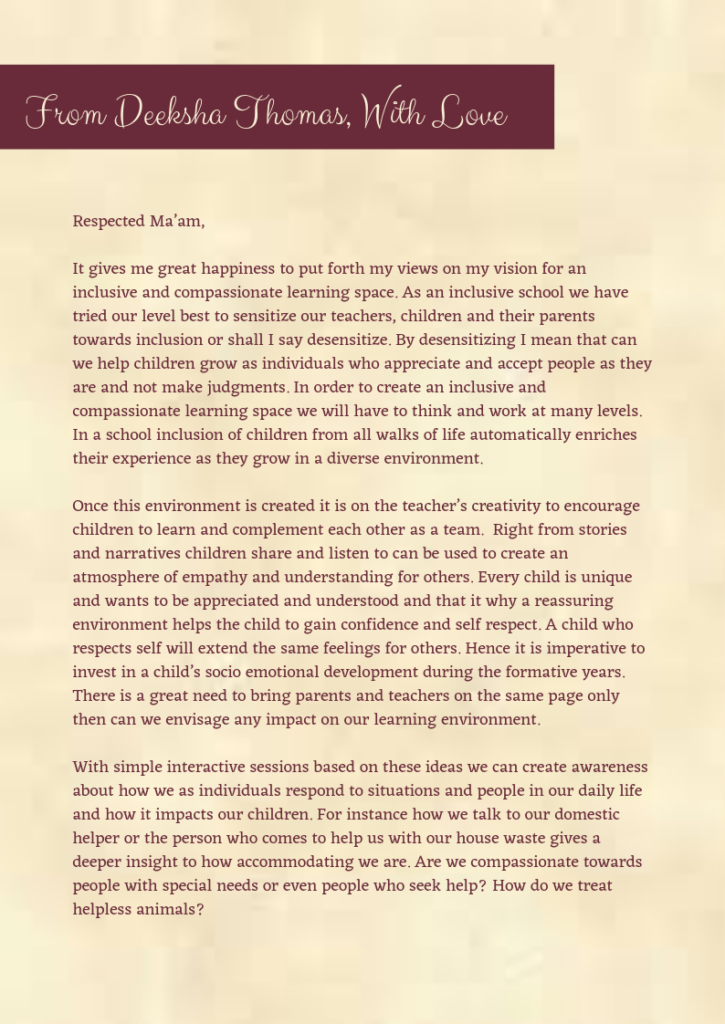

Respected Ma’am,
It gives me great happiness to put forth my views on my vision for an inclusive and compassionate learning space. As an inclusive school we have tried our level best to sensitize our teachers, children and their parents towards inclusion or shall I say desensitize. By desensitizing I mean that can we help children grow as individuals who appreciate and accept people as they are and not make judgments. In order to create an inclusive and compassionate learning space we will have to think and work at many levels. In a school inclusion of children from all walks of life automatically enriches their experience as they grow in a diverse environment.
Once this environment is created it is on the teacher’s creativity to encourage children to learn and complement each other as a team. Right from stories and narratives children share and listen to can be used to create an atmosphere of empathy and understanding for others. Every child is unique and wants to be appreciated and understood and that it why a reassuring environment helps the child to gain confidence and self respect. A child who respects self will extend the same feelings for others. Hence it is imperative to invest in a child’s socio emotional development during the formative years. There is a great need to bring parents and teachers on the same page only then can we envisage any impact on our learning environment.
With simple interactive sessions based on these ideas we can create awareness about how we as individuals respond to situations and people in our daily life and how it impacts our children. For instance how we talk to our domestic helper or the person who comes to help us with our house waste gives a deeper insight to how accommodating we are. Are we compassionate towards people with special needs or even people who seek help? How do we treat helpless animals?
We are great role models for our children as they are watching and listening to us all the time. Regular and seemingly not so important situations in our daily life could create a deep impression on the child’s mind. It will be a great learning experience for parents and teachers to come together and share their memories of such situation where they did a negative role modeling for their child, later when did they realize the impact it had on the child and then what did they do to help the child come out of it.
Can we as educators help people focus on their actions and become more mindful about the world around them. Is it possible to help people understand that diversity in the world around us makes us better human beings and we learn to appreciate and not judge people for their uniqueness?
In my early years of teaching (not at Santa Maria) I had asked my children to draw a picture of a pet if they had one. A child came to me with a picture of a dog with three legs. I got a bit uncomfortable to see the picture as I thought the child has not drawn it correctly. When I asked the child to correct it he said, “ Maam yeh mera pet dog hai Jaggi, Aur yeh special hai”. Child’s response shook me up and I felt very tiny at that moment. However the incident changed my perspective towards life. I learnt that there is actually nothing imperfect or incomplete in this world and made me reflect at my obsession with perfection.
It will be a great learning to introspect how we talk to our children, how we talk to others in front of them, do the spaces in and outside the classrooms reflect anything about inclusion, what kind of play material that we choose for our children, what kind of stories we share with our children, do we extend equal learning opportunity to all, how diverse and sensitive is our curriculum and above all how honest are we while actually working. I would conclude the letter by saying that inclusive space created on a paper and an inclusive space created in a person’s mind are two different things.
Warm Regards,
Deeksha Thomas
Click here to access other entries!
